His Majesty King Bhumibol Adulyadej The Great
Chapter 17: His Majesty’s Genius in Technology, Industrial Engineering, Transportation, and Telecommunications
His Majesty King Bhumibol Adulyadej The Great possessed exceptional intellect and ability in every branch of knowledge. He took great interest in experimentation, research, and self-directed study in various fields. His Majesty continuously applied both academic knowledge and practical experience to improve the quality of life and well-being of all his people. This is evident in more than 2,500 Royal Development Projects, each requiring the integration of multiple technological disciplines and branches of engineering such as surveying, marine engineering, electrical and communication engineering, agricultural engineering, irrigation engineering, mechanical engineering, and environmental engineering. His genius, proficiency, and far-sighted vision were recognized and admired both within the Kingdom and across the world, bringing immense and lasting benefit to humankind.
“Napath” wrote in the Engineering Journal of the Internal Security Operations Command, Vol. 6, No. 10, August (2001: 3–4) as follows:
“The concepts and theories of development based on His Majesty King Bhumibol Adulyadej’s initiative have unique characteristics. They are the result of His Majesty’s brilliance and ingenuity in creating, adapting, improving, and simplifying development processes so that projects could be implemented with ease, avoiding unnecessary complexity. ‘Simplicity’ was regarded as a guiding principle in all undertakings.
Beyond the principle of making things simple—which lies at the heart of His Majesty’s approach—He also emphasized the application of true understanding of natural laws and processes to solve problems and restore abnormal conditions to their natural balance. This is exemplified by His idea of using clean water to drive out polluted water, allowing it to return to a pure state in accordance with the natural rhythm of tidal flows.
Another distinctive feature was His focus on ensuring that the results of development efforts directly benefited the people from the outset. His Majesty’s approach was not bound by rigid academic theories but instead fostered knowledge, unity, and cooperation among all parties involved. He encouraged the reduction of institutional subjectivity and the sense of ownership that often hindered collaboration, promoting instead collective participation and shared purpose, ultimately delivering the greatest benefit to the people.”
An example of this can be seen in the Royal Development Study Centers, which introduced a new model of administration known as the “one-stop service” or “integrated service system” (One Stop Service for the Farmers). This approach marked the first genuine implementation of such a management system within Thailand’s public administration.
The concepts and theories bestowed by His Majesty as practical guidelines were often expressed in simple yet profoundly meaningful sentences, carefully refined and deeply insightful. In many instances, they inherently contained comprehensive methods for implementation, such as “Good water drives out bad water,” “Artificial soil deterioration,” and the “New Theory.” When categorized, the concepts and theories derived from His Majesty’s initiatives can be grouped into four major areas: water-related projects, soil-related projects, projects concerning the development and conservation of natural resources and the environment, and projects focused on social development and the improvement of quality of life.
1. Concepts and Theories Related to Water
It is widely acknowledged that His Majesty was the nation’s foremost expert on water. His concepts and theories concerning water were numerous and diverse. One notable example is the concept of “Good water drives out bad water,” developed to address pollution in the Chao Phraya River and various canals throughout Bangkok.
Another is the “Natural Kidney” concept, which was implemented to treat polluted water in Makkasan Swamp. Furthermore, His Majesty formulated ideas to resolve the problems of flooding and drought, which led to the construction of reservoirs for agricultural use.
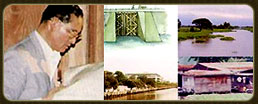
2. Concepts and Theories Related to Soil primarily focus on soil conservation and improvement for agricultural purposes. This includes the use of vetiver grass for soil preservation and erosion control, which has led Thailand to become the world’s leading center for successful and advanced techniques in vetiver grass application and research.
3. The Development and Conservation of Natural Resources and the Environment is another area initiated by His Majesty, emphasizing the harmony and interdependence between development and the conservation of natural resources, as well as the relationship between humans and nature. Examples of His Majesty’s concepts and theories in this field include the “Three Forests, Four Benefits” concept, which advocates planting three types of forests—forests for timber, forests for fruit, and forests for fuel—providing three direct benefits while also contributing to soil and water conservation and maintaining the forest’s natural moisture. Another well-known example is the theory for solving drought and water scarcity problems for agriculture, known as the “New Theory,” which became the foundation of the Sufficiency Economy Philosophy. This approach enables people to live in self-sufficiency—perhaps not in abundance, but with enough to sustain a stable and content life.
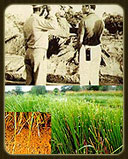
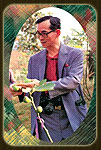
The New Theory is based on simple and practical principles. In summary, the average landholding of Thai farmers is about 15 rai. According to the New Theory method, the land is divided into 5 rai for rice cultivation, 5 rai for field crops and fruit trees, and 3 rai for residential area and a pond approximately 4 meters deep. The core principle of the New Theory is to enable farmers to achieve self-sufficiency at a modest level, allowing them to sustain themselves economically while also fostering unity and cooperation within their local communities.
4. Concepts and Theories on Social Development and the Promotion of People’s Quality of Life
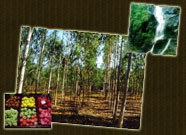
His Majesty’s approach emphasized that people should have a stake in their communities and participate in decision-making themselves (People Participation), from the initiation of projects to the involvement of all relevant parties in the government sector working together. This principle led to the establishment of Royal Development Study Centers across all regions of Thailand, representing a new model of administration within the Thai civil service system. At these centers, government agencies and units collaborate in one location, ensuring that those seeking knowledge and assistance do not need to spend time visiting separate organizations, as is common in the conventional system.
It is evident that the concepts and theories of development initiated by His Majesty King Rama IX are extensive and diverse, encompassing multiple fields of development and bringing immeasurable benefits to the people. Through His profound intellect and exceptional capability, His Majesty dedicated tireless effort and hard work throughout his life. These development concepts and theories deserve to be recorded and disseminated to honor His Majesty’s brilliance and achievements. Above all, they serve as a reminder for the people to recognize and deeply appreciate the boundless and extraordinary benevolence of His Majesty, who is dearly loved and highly respected by all Thai citizens.
The Engineering Institute of Thailand under Royal Patronage published the book “The King, the Great Engineer of the Land” to honor His Majesty King Bhumibol Adulyadej for his engineering genius (The Self–Taught Engineer), a title worthy of great admiration. His Majesty’s exceptional skill in adapting, repairing, and inventing various devices was evident throughout his life. Regarding His Majesty’s visit to aid flood-affected citizens in 1983, he remarked, “On the first day of driving, the engine stalled because water entered the exhaust pipe. I had to rebuild it, extending the exhaust pipe high above the water. Then we were able to proceed.”
His ingenuity in adaptation, repair, and invention was apparent even in his youth. As recorded by Her Royal Highness Princess Galyani Vadhana, Krom Luang Naradhiwas Rajanagarindra, in her book Little Princes, Young Monarchs, she described the special talent of His Majesty King Bhumibol Adulyadej as follows:
“… In various technical fields, whether mechanical, electrical, or radio engineering, he showed understanding from a very young age. There is already a story about how he repaired Nhaen’s sewing machine, but I will recount it again as Mother told me …” “… Normally, Mother would not give the children anything except on their birthdays or New Year. One day, Mother saw the younger sibling playing with a new car. When she learned that Nhaen had given it, she asked why he did so. Nhaen replied that he had repaired the sewing machine, and thus deserved a reward …”
Mom Luang Tawisarn Ladawan (1987: 26–27) recounted it as follows:
“His Majesty the King greatly enjoyed engineering and technical work. I would like to respectfully report that the university conferred an honorary doctorate in…
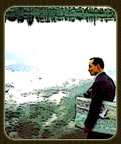
…in engineering, which was highly admired, as His Majesty had enjoyed technical work since childhood. He once told me that Her Majesty the Queen Mother taught Him to be frugal from an early age. Each toy He had was not purchased with money given by the Queen Mother, meaning He had to save or earn the funds Himself to acquire them.
To have toys of His own, and sometimes to actually possess them, His Majesty would create them Himself. For example, He invented a toy electric train, constructing the motor personally by winding copper wire around the motor’s core, connecting a single wire, and carefully applying Himself to the engineering work from a very young age. His skill in technical matters was remarkable. Some may not be aware of this expertise, so I take this opportunity to explain that whatever hobby He pursued, He studied it thoroughly and in depth. For instance, when the military and police reported problems with the use of M16 rifles being less effective than the AR rifles of insurgents, His Majesty paid close attention to the technical details.
As for the insurgents’ AK rifles, they could be thrown into water or buried in mud and still fire, whereas the M16 would fail unless it was carefully maintained and thoroughly cleaned. His Majesty studied these weapons seriously and discovered that some of the springs in certain M16 components were too weak. He informed the American authorities and the M16 manufacturers, who then made corrections, and the rifles subsequently performed well. This example illustrates His Majesty’s technical skill and ingenuity. In addition, I understand that many of the professors are already aware that He offered royal initiatives on the design of radio antennas, resulting in improved performance. “
Police Major General Suchart Phueaksakorn (2001: 3–4) recounted as follows:
“His Majesty the King showed great interest and possessed the virtues known as the Four Efforts (Ittibat 4) in various technical fields from a very young age. He graciously shared many stories with me, and I will highlight only a few related to electrical and radio engineering, which I had the opportunity to witness and serve directly.
The first story concerns the toy electric train. His Majesty described connecting an electric wire from a room in the palace down to the lower floor, then wiring it to a toy train motor. It was a single-wire direct current system: one wire connected to the motor terminal and the tracks connected to the ground. The earth served as the return path for the current, allowing electricity to flow through the motor to the ground via the tracks, causing the motor to spin and the train to run. To prevent His attendants from being electrocuted, the plug was marked with a skull and crossbones, along with the German word Achtung, meaning ‘Caution, Danger.’
The second story involved building sand walls and drainage channels while playing at the beach. This early application of the Four Efforts helped cultivate His Majesty’s encyclopedic knowledge in irrigation.
The third story concerns radio. With great interest, His Majesty used some of His personal funds to purchase radio components from a street vendor in Lausanne. He assembled a crystal radio receiver—one of the earliest in the world—using a cat whisker and coils wound in a hexagonal frame. After assembly, he connected it to a wire antenna and carefully adjusted the crystal until he could receive broadcasts from certain European stations. He was very pleased and proud of this achievement.”
The fourth story concerns the evolution of radio from crystal sets to tube-based receivers. His Majesty experimented by connecting a wire from the speaker in His bedroom to the speaker in the bedroom of His elder brother, King Rama VIII, creating a private intercom system. He was very pleased and proud of this innovation as well.
Here, we honor the engineering genius of His Majesty King Bhumibol Adulyadej by highlighting four major areas as follows:
1. His Majesty’s Genius in Technology and Engineering
1.1 His Majesty King Bhumibol Adulyadej’s Inventions in Agricultural Machinery
Mr. Banjong Watthanapong, a special expert in research and development of machinery at the Chaipattana Foundation (2001: 56), described the characteristics of His Majesty’s inventions and development of various agricultural machinery as follows:
His Majesty focused on creating agricultural machinery using simple technology and applying local wisdom—“Made in Thailand, used in Thailand”—to reduce dependence on foreign economies. The technology was effective, and when implemented in any region, it contributed to improving the quality of life and the environment for the people in that area. Furthermore, the materials used in these inventions were sourced locally and easily obtainable within the region. The designs emphasized ease of use, simple maintenance, and affordability.
On many occasions, when His Majesty visited development projects, He would provide guidance to government agencies on using technology for research, development, and invention of various machinery. These designs could then be applied and built to generate significant benefits for the nation.
In fact, the agricultural machinery developed under His Majesty’s initiative involved multiple agencies. For clarity, His directives regarding the use of technology for research, development, and invention of machinery can be summarized into two phases:
1.1.1 Phase One (from 1977 onward)
During this period, Thailand faced an energy crisis and severe flooding in Bangkok and surrounding areas. His Majesty gave guidance to government agencies to research, develop, and invent alternative-energy machinery, including:
1.1.1.1 Human-Powered Machinery: such as manually operated rice mills and rice threshers.
a. Human-Powered Rice Mill: This invention originated from His Majesty’s initiative on 4 February 1977, when He visited the hill-tribe communities at Doi Sam Moen, Chiang Mai. He observed a hand-cranked rice mill provided by the Japanese government to the Royal Project. The machine’s rotational speed was inconsistent, causing incomplete husking and requiring repeated milling, which created multiple steps and wasted effort. His Majesty instructed government officials to modify the rice mill to be foot-powered, like a bicycle pedal, providing a more consistent rotational speed. He also directed the creation of a husk separator, enabling the hill-tribe people—who were more skilled with their feet than hands—to produce husked rice suitable for cooking.
The redesigned human-powered rice mill was first produced and put into use on 1 September 1977, and His Majesty inspected it on 21 September 1977 at the Community Hall in Ripasago, Pattani. The mill could process approximately 200 kilograms of paddy per hour, using a centrifugal husk separation system at 2,800 rpm, operated by two people pedaling.
Later, His Majesty instructed the Royal Irrigation Department to further develop the human-powered rice mill, drawing inspiration from the Japanese model but applying a simple principle: the centrifugal force generated by the high-speed rotating paddles (about 2,800 rpm) would throw the husks off the paddy, producing husked rice with minimal breakage. The separated husks could be collected by a fan, while the rice remained suitable for cooking. Any remaining husks could be re-milled, significantly reducing labor and processing time compared to traditional pounding or grinding methods. This approach also produced more intact grains than conventional milling.
This type of rice mill was particularly suitable for remote communities, especially hill-tribe people who preferred husked rice (rice with the bran intact, or “vitamin rice”) rather than polished white rice, as they believed it helped prevent beriberi and promoted health. The foot-pedal rice mill, designed and produced by the Royal Irrigation Department, could husk 200 kilograms of paddy per hour, depending on the operator’s strength and skill.
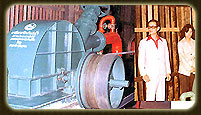
Human-Powered Rice Thresher and Rice Mill
This rice mill can also be adapted to use a 1-horsepower engine or electric motor instead of human power, making it suitable for husking “vitamin rice,” as it is designed to husk paddy and separate the husks.
From History and Development of Machinery under the Royal Initiative of His Majesty the King (1999: 10–13).
b. Human-Powered Rice Thresher This invention originated from His Majesty’s initiative on 21 February 1977, during a visit to the hill-tribe communities at Ban Wiang-Kae, Chiang Klang District, Nan Province. His Majesty observed that the locally made foot-operated rice threshers could not separate straw or immature grains from the paddy, requiring additional steps to sift out the debris. He instructed officials to modify the thresher into a foot-pedal type, like a bicycle: one person pedals while another holds the rice stalks, allowing the machine to thresh the paddy and separate straw and immature grains effectively. This significantly reduced processing steps and improved efficiency. From then on, human-powered rice threshers were produced. Both the thresher and the rice mill were intended for use as communal machines in villages: villagers would first thresh the rice and then mill it to obtain husked rice for cooking. This process also provided physical exercise for the users while producing hygienic rice.
c. Royal Rice Mills The journal Technology for Villagers, Volume 14, Issue 276, 1 December 2001 (p. 69) described the Royal Rice Mills. The outstanding features of these mills are as follows:

The rice mill is a modern system entirely designed, manufactured, and installed by Thai people. It uses an electric motor as the power source, with independently controlled operations, and can run continuously 24 hours without problems.
It can mill all types of rice, including jasmine rice, glutinous rice, and ordinary white rice, achieving 100% first-grade quality suitable for export. Its production capacity is no less than 60 carts of paddy per day, with an average electricity cost of approximately 50–60 baht per cart.
The mill produces high-quality rice with low breakage and loss, using a special three-stage polishing system and a rice polishing mechanism. It also features a temperature control system during milling to cool the grains and a sorting system to separate brown rice for sale.
The resulting rice is visually appealing, with full grains and intact germ, and the white rice is glossy, suitable for export.
The milled rice is sorted into four grades: whole grains, large broken grains, small broken grains, and rice tips. Notably, the yield of whole grains is 4–5% higher than traditional milling systems using the same batch of paddy.
Byproducts of milling include four types: small broken rice, husks, coarse bran, and fine bran, all of which can be sold.
The entire mill requires only one operator, and maintenance is minimal, involving only replacement of rubber rollers and sieve plates.
The mill includes a proper system for collecting husks, bran, and dust, preventing environmental pollution and complying with the Environmental Protection Act.
The mill is equipped with an electric control cabinet, displaying machine operation on a chart and providing warning signals in case of malfunctions or emergencies.
All machinery is manufactured in Thailand, meets international quality standards, and is registered with the Department of Industrial Works, Ministry of Industry.
This rice milling machinery received the highest honor from the Thai government, with the Prime Minister presenting the award to the Rice Company as the Outstanding Rice Mill Exporter of 1998 (Prime Minister’s Export Award 1998).
The Royal Rice Mill Project is another initiative under His Majesty King Bhumibol Adulyadej’s guidance, aimed at solving rice production and marketing problems, preventing exploitation by middlemen, ensuring cost-effective production, and maintaining rice quality. Byproducts—small broken rice, husks, coarse and fine bran—can be sold to other factories for further use, allowing farmers to increase their savings and reduce hardship. This represents His Majesty’s profound benevolence toward rice farmers, providing them with a reliable milling system under royal guidance.
1.1.1.2 Animal-Powered Machinery: including royal carriages for 5-passenger and 2-passenger types. These were commissioned on 16 February 1981 for use in His Majesty’s private activities, modeled after carriages used in Australia. Three carriages were produced:
a. A 5-passenger carriage drawn by 1–2 horses, 1 unit.
b. A 2-passenger carriage drawn by 1 horse, 2 units.
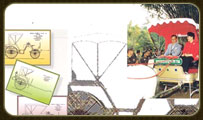
These carriages were presented as royal carriages to His Majesty King Bhumibol Adulyadej and Her Majesty the Queen Mother on 19 March 1992 at Pang Tong Palace, Mok Champae Subdistrict, Mueang District, Mae Hong Son Province. They were also presented as royal carriages to Her Royal Highness Princess Maha Chakri Sirindhorn in Lampang Province and Ratchaburi Province.
1.1.1.3 Water-Powered Machinery: including water rams, floating waterwheel pumps, waterwheel pumps, small-scale hydropower generators, and flow-driven pumps or the Chai Pattana Hydro Pump.
a. Hydraulic ram, or water ram.
The hydraulic ram was invented under royal initiative on 8 January 1979, when His Majesty King Bhumibol Adulyadej visited the Mae Mon Weir Irrigation Project in Chae Hom District, Lampang Province. Observing that the weir had a significant height and a continuous overflow of water, His Majesty realized that a hydraulic ram, similar to the one used at Mae Faek Weir in Mae Rim District, Chiang Mai Province, could be installed at various weirs to pump water to higher areas. This would provide communities on elevated land with water for consumption and daily use. His Majesty thus instructed government officials to develop and install such hydraulic rams at overflow weirs nationwide, harnessing water power for versatile and beneficial purposes.
b. Floating waterwheel pump
The floating waterwheel pump was developed under royal initiative on 21 February 1981, when His Majesty King Bhumibol Adulyadej visited the Special Handicraft Center at Huai Duea, Pha Bong Subdistrict, Mueang District, Mae Hong Son Province. Observing that the area suffered from water shortages for mulberry cultivation and silkworm rearing, and noting that it lay along the Pai River, which had a strong and continuous flow, His Majesty instructed government officials to develop a waterwheel pump. This pump would lift water from the river to the center for mulberry cultivation, as well as for domestic use. Initially, it served as a temporary solution until a weir could be constructed to divert water into the area.
c. Waterwheel-driven pump
Invented under royal initiative on February 16, 1982, His Majesty King Bhumibol Adulyadej visited the Pang Tong Hydropower Plant at the Pang Tong Development Center, Mok Champae Subdistrict, Mueang District, Mae Hong Son Province. He noted that the hydraulic ram, or “ta-ban-nam,” installed at the Pang Tong 3 weir in front of the Pang Tong Palace, produced disturbing noise during operation. His Majesty suggested developing an improved system by creating a water turbine to drive the pump, which would be more suitable and quieter. The user only needs to open the water gate for the machine to operate and close it to stop. Accordingly, His Majesty gave guidance to officials to develop two types of waterwheel-driven pumps:
- Cross-flow water turbine pump
- Globed case co-axial water turbine pump
d. Flowing-water pump
Invented under the royal initiative, on 14 March 1989, His Majesty King Bhumibol Adulyadej (Rama IX) visited Ban Rerm irrigation canal, Mae Taeng Subdistrict, Chiang Mai Province, to observe the trial of a flowing-water pump, or sling pump, which had been graciously presented by the King of Sweden. His Majesty observed that using this pump could encounter problems with debris and algae clogging the impeller and suction inlet. Therefore, He gave the royal directive to the relevant government officials to improve and develop the pump using domestic materials, so that it could be deployed in rivers and streams with sufficient current. This would allow local residents living near water sources to use the flowing water to irrigate their vegetable gardens. The advantage of this pump is its light weight; it can be easily placed in the river for use and lifted out when not in use, making efficient use of water current for pumping.
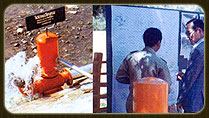
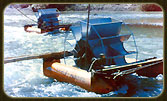
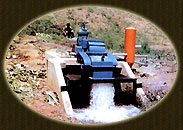
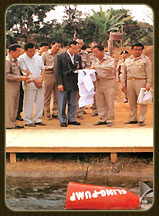
e. Mae Sa Mai Village Hydropower Rice Mill: Constructed under the royal initiative in 1975, His Majesty King Bhumibol Adulyadej visited the hill-tribe villagers of Mae Sa Mai, Mae Rim District, Chiang Mai, regularly. In 1975, upon observing the villagers’ hardships due to water shortages, His Majesty desired to provide them with water for agriculture, consumption, and daily use. He therefore gave royal directives to government officials to build a diversion weir to fill a high-level reservoir, from which water would be piped down to the hydropower rice mill. The mill utilized the water’s energy for rice milling and electricity generation. Afterwards, the water was further used for agriculture, consumption, and daily needs, exemplifying the multifaceted benefits of harnessing water power.
f. Doi Ang Khang Hydropower Plant: Constructed under the royal initiative on 4 February 1977, His Majesty King Bhumibol Adulyadej visited the Royal Agricultural Research Station at Doi Ang Khang, Fang District, Chiang Mai. Prince Piset Ratchanee requested a project to generate hydropower as an alternative to fuel energy. His Majesty therefore gave royal directives to government officials to build a diversion weir to fill a high-level reservoir, channel the water into the hydropower plant, and store the water in a lower reservoir in front of the plant. Afterwards, the water was further used for agriculture, consumption, and daily needs, maximizing the benefits of water energy.
The project aimed to fully utilize water resources according to the royal intention while addressing fuel shortages. The benefits included: (1) generating electricity, (2) saving diesel fuel for electricity generation, averaging approximately 200,000 baht per year, (3) saving lubricating oil costs, averaging 31,635.38 baht per year, (4) providing water for agriculture, and (5) supplying water for consumption—ensuring every drop of water was used effectively for all five purposes.
His Majesty directed the Royal Irrigation Department, through Irrigation Office 1, to construct a 700-cubic-meter reservoir, a diversion weir, and a 1,000-cubic-meter forebay in front of the plant, lay water pipes to the turbines, and build the hydropower plant. Irrigation Office 2 was responsible for designing and installing the water pipelines, the plant structure, and the electrical system within the Doi Ang Khang Royal Agricultural Station, completing the project successfully.
g. Pang Tong Development Center Hydropower Plant: Constructed under the royal initiative on 22 October 1980, His Majesty King Bhumibol Adulyadej visited the Pang Tong Development Center in Mueang District, Mae Hong Son. He observed that electricity generation using diesel engines was difficult due to the challenge of transporting fuel. Since the center had abundant water sources and several diversion weirs, His Majesty gave royal directives to government officials to channel water from high-level weirs into the hydropower plant for electricity generation. The water, after passing through the turbines, was sent to a lower weir and then piped for agricultural use, consumption, and daily needs—maximizing the utility of water energy.
1.1.1.4 Machinery Using Engine Power: Includes water propulsion machines (to increase water flow speed in canals) powered by diesel engines. Following the major flood of 1983, His Majesty directed that long-tail boat engines be adapted to accelerate water drainage in various canals.
1.1.2 Second Period (From 1988 Onwards): During this period, the water environment had severely deteriorated, and government agencies alone could not respond effectively. In addition, community settlements were expanding rapidly and densely. His Majesty gave royal directives to government agencies to develop various types of aeration machinery for use in wastewater treatment, as follows:
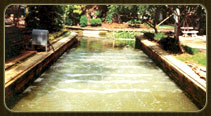
1.1.2.2 Surface aeration machinery with slow rotation, or the “Chaipattana Turbine” Chaipattana Aerator, Model RX-2
1.1.2.1 Aeration machinery that blows air into water and disperses bubbles Chaipattana Aerator, Model RX-1
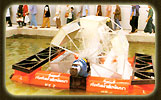
The Chaipattana Water Turbine (a slow-rotating surface aeration machine with a floating buoy) is an invention of His Majesty King Bhumibol Adulyadej (Rama IX) that has been widely admired and internationally recognized. It received a total of six awards at the 49th World Exhibition of Inventions, Research, and Technology held in Brussels, Belgium, in 2000 (Matichon, 6 October 2001: 20).
Background of the Chaipattana Water Turbine
Solving the problem of water pollution is part of improving and developing the environment of community areas, which has become increasingly severe due to population growth and dense urban living. Wastewater discharged into public canals without treatment causes contamination to spread widely in ponds, drainage canals, swamps, wells, and rivers, making it difficult to collect wastewater from various sources for transport to treatment plants. While sewage treatment systems have begun to be implemented in Bangkok and other major municipalities, they are limited by budget constraints and their effectiveness is still insufficient, providing only temporary relief.
His Majesty King Rama IX was deeply concerned about the environment and the welfare of his people, particularly regarding crowded conditions and polluted water that could affect health and hygiene both in Bangkok and the provinces. He therefore provided guidance on various approaches to wastewater treatment. In the early period from 1984 to 1987, clean water was used to help dilute pollution, along with filtering wastewater through water hyacinths and other aquatic plants, which provided partial remediation. From 1988 onward, as water pollution became more severe and public canals emitted unpleasant odors, it became necessary to introduce aeration devices to increase the oxygen content in the water to assist in wastewater treatment.
Additionally, His Majesty provided a design that was simple, economical, and could serve as a prototype for agencies to replicate and implement easily. He graciously commissioned the Chaipattana Foundation to support funding for research and development of this invention, and to collaborate with the Royal Irrigation Department in producing the aeration equipment. This aeration device, commonly known as the “Chaipattana Water Turbine”, has become widely used across the country.
Characteristics of the Aeration Device
The aeration device, commonly called the Chaipattana Water Turbine, is a slow-rotating, floating-surface aerator capable of transferring up to 0.9 kilograms of oxygen per horsepower-hour. It can be used in diverse wastewater treatment applications and is easy to install. It is suitable for natural water bodies such as ponds, swamps, canals, reservoirs, and streams with a depth greater than 1.00 meter and a width exceeding 3.00 meters. The device can be installed in a fixed location or move along the waterway autonomously. In areas with electricity access, it can be powered by an electric motor. In locations without electricity, it can be adapted to use an engine as the power source, with operators controlling and adjusting the direction as needed.
Patent Application
To honor His Majesty King Rama IX, who conceived and graciously provided the design and concept for the aeration device, enabling it to operate effectively for wastewater treatment and generate significant public benefit, the Chaipattana Foundation requested royal permission to apply for a patent for the slow-rotating, floating-surface aeration device (Chaipattana Water Turbine) in the name of His Majesty King Rama IX.
The patent application proceeded through the normal legal process, which is worth recording as follows:
His Majesty King Rama IX graciously granted royal permission for the Chairman and Secretary-General of the Chaipattana Foundation (Mr. Sumet Tantivejkul) to act as representatives in applying for the patent.
Subsequently, the Chaipattana Foundation carried out the patent application in accordance with the Patent Act B.E. 2522 (1979), including the payment of all required fees for the procedure.
Steps for Examining an Invention
1. The Chaipattana Foundation submitted a patent application to the Department of Intellectual Property, Ministry of Commerce, for preliminary examination. The Department of Intellectual Property sent the patent application for prior art search to the Australian Patent Office. The examination results revealed eight existing registered patents: five from the United States, one from France, and two from Australia. Among these, one document was closely related—a patent from Australia.
2. The Department of Intellectual Property, Ministry of Commerce, conducted a step-by-step examination of the invention, including assessments of novelty, inventive step, and industrial applicability in commerce, agriculture, or craftsmanship.
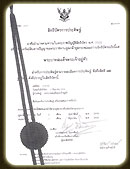
3. The Department of Intellectual Property proceeded with the registration and issuance of the patent for the Chaipattana Aerator. His Majesty King Rama IX graciously authorized the Minister of Commerce (Mr. Uthai Pimjaichon), the Deputy Minister of Commerce (Mr. Jurin Laksanawisit), their delegation, and the Chairman and Secretary-General of the Chaipattana Foundation (Mr. Sumet Tantivejkul) to pay a courtesy visit to Her Royal Highness Princess Maha Chakri Sirindhorn on His behalf and present the patent at Chitralada Royal Villa, Dusit Palace, on 2 July 1993. This aerator was the ninth patented invention in the world and marked the first time a patent had been granted to a member of the royal family.
“Surely there is no one in this world—regardless of race, language, distance, or prior familiarity with Thailand or Thai people—who would not feel both astonished and deeply moved by the fact that the King of Thailand was able to accomplish this… That is, being granted a patent for the invention of the aeration machine to assist citizens affected by the deterioration of water environments, which is a major global problem today. This patent is the first in the name of a Thai monarch in the history of the nation, and also the first of its kind in the world.” (Chaipattana Foundation, 1993: 4–12)
1.1.2.3 Aeration machine with submerged rotating air blower, or “Chaipattana Super Bubble Aerator”
Chaipattana Aerator, Model RX-3
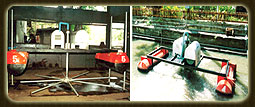
1.1.2.4 Submerged pressurized aeration machine, or “Chaipattana Venturi” Chaipattana Aerator, Model RX-4
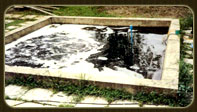
1.1.2.5 Compressed and suction-type submerged aeration machine, or “Chaipattana Air Jet”
Chaipattana Aerator, Model RX-5

The Matichon newspaper, issue dated October 6, 2001, page 20, mentioned another invention by His Majesty the King as follows:
The second patent was presented to “The King” for the invention of the “aerator.”
On October 5, 2001, at Klai Kangwon Palace, Hua Hin, Mr. Adisai Bodharamik, Minister of Commerce, respectfully presented the patent for the invention of the “air-compression and water-suction aerator” to His Majesty King Rama IX.
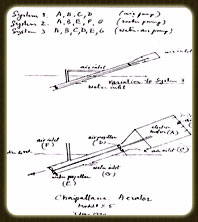
Mr. Adisai stated that His Majesty King Rama IX possessed remarkable ingenuity in inventing the “Chaipattana Water Turbine” and received the first patent in 1993. His Majesty continued to invent and develop other types of aerators, particularly the “air-compression and water-suction aerator,” achieving high quality. The patent application was submitted to the Department of Intellectual Property on January 16, 2001, under application number 063072, and it was registered and granted patent number 10304 on April 19, 2001.
Mr. Adisai explained, “The air-compression and water-suction aerator differs from the Chaipattana Water Turbine in that it injects compressed air while drawing water from the bottom of the pond. The air mixes with the water and is then sprayed out, creating both horizontal and vertical circulation, ensuring that the water is evenly aerated throughout.”
Note: The air-compression and water-suction aerator consists of a floating frame for installing the air-compression and water-suction unit driven by an electric motor. The motor shaft is mounted vertically to drive the rotating shaft of the suction and air-compression assembly, which draws air from the surrounding area and blows it out through the air pipe. This rotating shaft extends downward to the water pump, which draws water from the pond bottom and ejects it through a venturi pipe. This creates a pressure difference that generates suction, pulling air into the mixing chamber before being expelled under the water surface horizontally.
According to the Matichon newspaper, May 9, 2001 (p.25), Mrs. Phongsri Yutsasarnprasit, Director-General of the Department of Intellectual Property, stated: “This invention by His Majesty the King, granted a patent, meets the patent conditions under the Patent Act B.E. 2522 as amended by the Patent Act (No. 3) B.E. 2542. It is a new invention, involves an inventive step, and is applicable in industry. The air-compression and water-suction aerator is a new invention beneficial to agriculture, enhancing national agricultural production, similar to the previously applied Chaipattana Water Turbine.”
1.1.2.6 Water-paddle aerator, or “Chaipattana Water-Paddle Aerator,” Chaipattana Aerator, Model RX–6
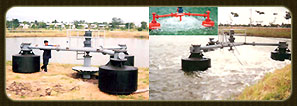
1.1.2.7 Suction and sub-surface air-compression aerator, or “Chaipattana Hydro-Air,” Chaipattana Aerator, Model RX–7
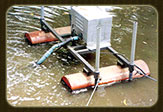
1.1.2.8 Microorganism attachment device, or “Chaipattana Bio,” Chaipattana Aerator, Model RX–8
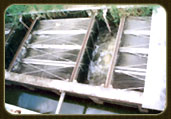
1.1.2.9 Aeration device with water-surface contact, or “Chaipattana Fountain,” Chaipattana Aerator, Model RX–9A and RX–9B
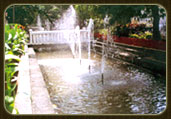
1.2 Inventions Created During Periods Free from Royal Duties: “Ant Sailboat”
His Majesty King Bhumibol Adulyadej (Rama IX) studied carpentry while he was studying in Switzerland. He enjoyed sawing and planing wood for many hours. These wooden frames eventually became the first sailboat, part of a total of seven sailboats that he personally constructed (Wilas Maneewat, 2000: 150).
The first “Ant Sailboat” was Sailboat No. 1, which he took to compete in England during that royal visit, and he was able to win against other competitors’ boats of similar size (Poonporn Saengbangpla, 1987: 215–222).
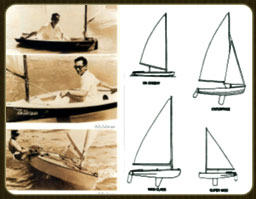
The “Ant Sailboat” designed by His Majesty King Bhumibol Adulyadej (Rama IX) is a single-masted sailboat of the One-Design class. This design is considered suitable for racing, as it is inexpensive to build, easy to store, lightweight, and convenient for transport and handling. It also has excellent maneuverability when sailing and tacking. These advantages contributed to establishing a standard for another class of competitive sailboats.
1.2.1 Specifications of the Ant Sailboat
- Length = 11 feet
- Beam (width) = 4 feet 7 inches
- Draft (depth) = 1 foot 7 inches
- Sail area = 70 square feet
- Weight = 35 kilograms
- Mark = Ant symbol
1.2.2 Materials and Construction
All materials used in building the sailboat were sourced domestically. The hull is made of water-resistant plywood with special adhesive from a Thai plywood company. Lightweight and durable woods, such as Yom Hom or Song wood, were used, especially for the structural frame and mast. The sail is made from light, non-porous fabric. Rigging hardware is made of stainless steel. The boat is coated with durable epoxy paint resistant to saltwater and firmly adhered to the hull.
1.2.3 Construction Steps
Step 1: Hull sheets (three sheets of 4 mm water-resistant plywood) are joined and shaped according to the blueprint. This stage is called “Pla Haeng” (dried fish), as named by His Majesty.
Step 2: Hull assembly – the sheets are wrapped and joined to the keel and tied with wire along pre-drilled lines, then glued. Once dry, the wires are removed, seams are finished inside and out, and reinforced with fiberglass.
Step 3: Construct structural components – assemble stern and mid bulkheads, rudder housing, and deck framework, then paint the interior to preserve the wood.
Step 4: Install the deck, finish the boat, and paint the exterior.
1.2.4 Ownership of the Design
After His Majesty King Rama IX designed and built the first Ant Sailboat and tested it in competitions both domestically and internationally, it was found that this sailboat—later named Ant 1—was highly maneuverable and suitable for racing. His Majesty granted royal permission for the Naval Dockyard Club to build additional Ant sailboats. The construction was carried out during non-working hours to avoid any impact on official duties. The club built multiple sailboats for those interested, which allowed the dockyard craftsmen to enhance their boat-building skills and earn extra income from their regular work. Part of the revenue from building the boats was presented to the designer, recognizing His Majesty as the owner of the design (or what would now be considered the patent holder). This marked the beginning of His Majesty’s contribution to developing the boat-building industry and starting boat-building business in Thailand.
Later, His Majesty improved the Ant sailboat design and created two more types of sailboats: the Super Ant and the Micro Ant, which became very popular among Thai sailing enthusiasts.

His Majesty King Rama IX possessed unparalleled skill in craftsmanship. His work in designing and building sailboats clearly demonstrated his extraordinary genius, leaving no room for dispute, and showcased his ability to integrate knowledge of architecture and engineering seamlessly.
Later, His Majesty gave royal directives to the Royal Thai Navy to build boats for official use, specifically to serve as fast patrol boats for coastal defense.
The T.91 Boat Project – The patrol boat was named “T.91,” where “T” denotes the type of boat, “9” refers to King Rama IX, and “1” indicates that it is the first boat of this series.
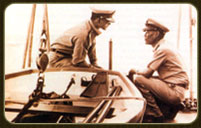
At that time, the Commander-in-Chief of the Royal Thai Navy, Admiral Jaroon Chalermthian, initiated a project to build one coastal patrol boat as a two-year project, starting in the fiscal year 1967, with a total budget of 13,445,000 baht. The design was created by officers who had graduated from abroad. King Rama IX assisted by coordinating with the National Ship Design and Research Institute of the United Kingdom to conduct satisfactory model tests. The boat was then constructed at the Naval Dockyard by its own craftsmen, under the supervision of Rear Admiral Udom Sutthasna Ayudhya, who was the Dockyard Director at that time.
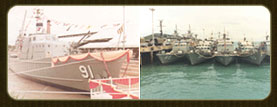
During the speed test of the vessel, the Naval Dock Department conducted the trials at the Koh Si Chang measured mile. His Majesty King Bhumibol Adulyadej (Rama IX) personally took part in the test and graciously offered his observations and advice regarding the vessel’s performance. Admiral Udom Suthat Na Ayudhya recounted, His Majesty was exceptionally intelligent, observing every detail with great attentiveness. He pointed out the flow of water from the stern and accurately concluded that there was an error causing the vessel to fail to reach the intended speed. Upon inspection, it was found that the propeller was indeed of the wrong size, pushing too much water and causing the engine to overwork, preventing acceleration. Consequently, both the propeller and the hull were adjusted and improved, successfully increasing the speed from 18 knots to 20 knots.
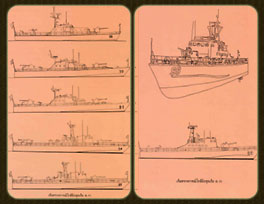
His Majesty King Bhumibol Adulyadej (Rama IX) graciously presided over the keel-laying ceremony of Torpedo Boat No. 91 on 12 July 1967. Her Majesty Queen Sirikit, the Queen Mother, presided over the launching ceremony on 9 May 1968. The vessel is currently in active service with the Patrol Boat Squadron.
The Royal Thai Navy has since constructed up to the ninth vessel, Torpedo Boat No. 99. For this vessel, modifications were made to increase the draft from 1.5 meters to 1.6 meters and the displacement from 117 tons to 130 tons. A new fire control system (Sea Archer) was also installed. Torpedo Boat No. 99 was completed in time to commemorate the 60th Birthday Anniversary of His Majesty King Bhumibol Adulyadej in 1987.
His Majesty King Bhumibol Adulyadej was not only visionary, wise, and farsighted, but also tireless in his dedication. Despite his numerous royal duties, he closely followed the progress of the Navy’s shipbuilding projects and continually offered guidance and support. His vision for the Royal Thai Navy to build its own vessels demonstrated profound foresight. Domestic shipbuilding not only strengthened national maritime defense but also enhanced the Navy’s technical and practical expertise in shipbuilding technology. Furthermore, it supported the growth of the domestic shipbuilding industry, both directly and indirectly, benefiting Thailand’s economy and society as a whole. The Thai people, especially naval officers, regard this as a boundless expression of His Majesty’s benevolence.
1.3 His Majesty’s Proficiency in Mathematics
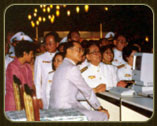
His Majesty King Bhumibol Adulyadej (Rama IX) possessed exceptional proficiency in various technical fields, widely recognized by all. His expertise extended to water resource engineering, cartography, agricultural engineering, and radio communications. His Majesty’s deep interest and earnest pursuit of knowledge drove him to study and conduct in-depth research for development in the fields of science, engineering, agriculture, irrigation, environmental conservation, and the application of technological innovations—particularly in computer science.
1.3.1 His Majesty’s Interest and Self-Study in Computing
In the field of information technology, His Majesty recognized its great importance and benefits, and he actively supported research in computer science, or computing. His deep interest was evident whenever he visited academic exhibitions at universities and technological institutes to observe the latest developments. His Majesty was genuinely interested in computing and made extensive practical use of it—unlike many senior administrators who were often hesitant to use computers themselves out of fear of the technology or concern about losing face before their subordinates. However, His Majesty King Bhumibol Adulyadej (Rama IX)…
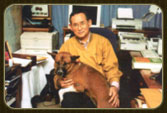
His Majesty, on the contrary, served as a model of a modern leader. He was never afraid of computers but was instead eager to study and explore their usefulness, even offering guidance to others. His Majesty used computers for typing his personal writings and organized them systematically into separate subjects. These works included records of his royal duties as well as his literary compositions, such as The Man Who Put Gold Leaf on the Back of the Buddha Image, among others.
1.3.2 His Majesty’s Ability to Use Computers for Composing Royal Musical Scores
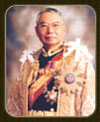
The background of His Majesty’s introduction to computers was recounted by M.R. Asnee Pramoj, a Privy Councillor. He observed that His Majesty exerted great physical effort and became weary from meticulously hand-copying musical scores that he had composed to present to musicians. Each note and line had to be carefully written by hand. M.R. Asnee learned that a personal computer, or PC, could be used to record and print musical notes. Therefore, he conceived the idea of obtaining such a computer for His Majesty’s use as a tool to assist in copying music. Eventually, M.R. Asnee Pramoj decided to purchase a Macintosh Plus computer.
This computer was the most advanced of its time. One of its special features was the ability to store and print musical scores. Learning to use it was not difficult, and it could also be connected to specialized equipment to play music according to the stored scores. M.R. Asnee Pramoj recounted that…
“Regarding the computer, His Majesty once mentioned that he knew nothing about it. However, I saw that the Macintosh was easy to use, so I presented it to Him. It turned out that His Majesty was very interested and meticulous. Upon receiving the computer, He began to study and learn how to operate it thoroughly on His own… No one taught or guided Him, except for one communications officer who assisted with certain tasks.”
His Majesty King Bhumibol Adulyadej (Rama IX) used this computer for music composition, employing three software programs: Concertware, Deluxe Music Construction, and Professional Composer. These programs could be connected to a MIDI interface to work with an electronic organ.

An example of the ConcertWare program used by His Majesty for composing musical scores
1.3.3 His Majesty’s Creation of Thai Typeface
His Majesty’s careful and dedicated interest in various fields was well known to those who worked closely with Him. During a visit to a technology exhibition at King Mongkut’s Institute of Technology, Ladkrabang, He inquired in depth about various projects. Professor Dr. Pairat Thatchayapong of the institute recounted:
“Our institute presented several projects for His Majesty’s observation. One was a Thai-Japanese and Thai-English translation system. After hearing the report, He asked about details such as the number of strokes in Japanese characters and the type of font used to display characters on the screen and printer, including how many points were in the grid arrangement. We never expected that His Majesty would be knowledgeable enough to ask such questions.”
His Majesty King Bhumibol Adulyadej (Rama IX) developed a deep interest in computer fonts after studying and using computers for musical notation around December 1986. He experimented with Fontastic and Resource Editor to format characters and used MacWriter for typing in February 1987. Later, an IBM PC compatible computer was presented to Him, and He explored software development, creating new command sets, improving software, and modifying existing programs, such as CU Writer for Thai language, according to His intentions.
His Majesty designed Thai typefaces for display on computer screens and printers for His personal use. Several styles were created, including Chitralada and Phuping, ranging from the largest to the smallest sizes, all exhibiting elegance. He also intended to create typefaces for other languages, such as Japanese characters.
1.3.4 His Majesty’s Creation of Command Sets for Displaying Ancient Indian Characters
While designing Thai typefaces was relatively straightforward due to the fixed forms of each character, many computer specialists today compete to create various Thai fonts for producing aesthetically pleasing documents. Each font set has a name chosen by its designer. His Majesty, however, turned His attention to displaying Devanagari characters on computer screens. Unlike Thai, Devanagari—an ancient Indian script, referred to by His Majesty as “Indian language”—is more complex because its characters are not fixed. When certain characters are combined, parts of one character merge with parts of another to form a new composite character, similar to contemporary Hindi script. Even professors at the Indian Institute of Technology in Kanpur, who research rendering Hindi characters on computers, acknowledged that creating such fonts is no easy task.
Nevertheless, His Majesty King Bhumibol Adulyadej (Rama IX) devised a method to display Devanagari characters on a computer screen. He began creating Devanagari characters around May 1987, studying the script independently from dictionaries and Sanskrit textbooks, and consulting experts in Pali and Sanskrit, such as Her Royal Highness Princess Maha Chakri Sirindhorn and Privy Councillor M.R. Jirayu Noppawong, who verified the accuracy of the characters. During a visit to the Asian Institute of Technology to observe computer technology, His Majesty humorously remarked, “Is there a prize? If I finish the Indian language, I’ll come to collect the award.”
On the occasion of His Majesty’s visit to the “Chula Academic Exhibition” at Chulalongkorn University on 23 November 1987, He presented the Devanagari command sets for the first time, including phonetic symbols. His Majesty demonstrated the system to professors and students, explaining the characteristics and usage of the characters and even typed the names of the professors and Her Royal Highness Princess Maha Chakri Sirindhorn for them to see. Examples included the following:
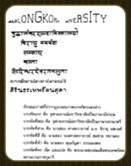
Devanagari characters
The reason His Majesty was deeply interested in Devanagari characters was his serious and thorough study of Buddhist teachings. His study of the script aimed to enhance his understanding of philology and to gain clearer insight into the subjects of Dharma. This demonstrates His Majesty’s profound discernment, as the original teachings and principles of Buddhism originated in India. Over time, these deep and complex teachings could be misinterpreted or altered, even though they were later recorded in the Tripitaka, which may not fully reflect the original intent. Therefore, by studying ancient Indian languages, one could attain a clearer and more accurate understanding of the Dharma. His Majesty King Bhumibol Adulyadej (Rama IX) made extensive use of Devanagari characters in his studies, as seen in his literary work Phra Mahachanok, where, in certain passages, he used Devanagari to mark the word “Artha” in the Jataka tales, emphasizing precise meaning and explanation.
บรรดาบทเหล่านั้น บทว่า เอวํ คเต ความว่า ในห้วงน้ำ ซึ่งประมาณมิได้
เห็นปานนี้ คือในมหาสมุทรทั้งลึกทั้งกว้าง. บทว่าธมฺมวายามสมฺปนฺโน ความว่า
ประกอบด้วยความพยายามอันชอบธรรม. บทว่า กมฺมุนา นาวสีทสิ ความว่า
ท่านไม่จมลงด้วยกิจคือความเพียรของบุรุษของตน. บทว่า ยตฺถ เต ความว่า ใจ
ของท่านยินดีในสถานที่ใด ท่านจงไปในสถานที่นั้นเถิด.

1.3.5 His Majesty’s Creation of Royal New Year’s Greeting Cards
In addition to studying and designing typefaces and using computers for writing and recording his literary works, another significant achievement was His Majesty’s use of computers to create Royal New Year’s greeting cards. He began using a computer to send New Year’s greetings at the end of 1975 for the year 1976, incorporating the song “Rao Su” and providing English translations for each section. Later, he created the 1978 greeting card by using a composition titled “Which warrior, steadfast in heart, immediately rejoices” from his work Nai In, the One Who Serves Behind the Scenes, signing it with the pseudonym “K.S.9 Prung/Song” and sending it via Telex to officials in all branches and units. In 1986, His Majesty used his own typeface and the pseudonym “K.S.9 Prung” for the 1987 greeting card, distributing it to relevant officials and members.
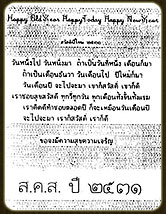
Later, in 1988, His Majesty began using a computer to “compose” New Year’s greetings to present to soldiers and police officers serving in remote areas, as well as to the general public. In subsequent years, He graciously continued to issue these computer-generated Royal New Year’s cards to the people every year, a tradition that continues to the present. These Royal computer-generated cards hold immense value, and each year citizens eagerly anticipate receiving them as a source of blessing and guidance in life, family, and work. The messages in each year’s card convey profound meaning, as exemplified below:
His Majesty supported the development of the Buddhist Scriptures in computer format. In his royal duties related to computing for Buddhism, as the Supreme Patron of Buddhism, He graciously contributed 1,472,900 baht of his personal funds in May 1991 to Mahidol University to develop a computer system for studying the Tripitaka and its commentaries. This project continued from the original computer-based Tripitaka project previously completed by Mahidol University and was presented to the King in celebration of the Coronation Anniversary. His Majesty personally studied the computer-based Tripitaka and commentaries and determined that the commentaries and judicial opinions should be compiled together. He then provided guidance and royal insight in designing the software for information retrieval.
This royal initiative ensured the continuity and sustainability of Buddhism for the future. The project played a crucial role in facilitating the study of the Tripitaka and its commentaries efficiently, accurately, and comprehensively. It also directly supported the dissemination of Buddhist teachings. The endeavor exemplifies an appropriate and creative application of advanced computer technology.
The computer system development project for studying the Tripitaka and its commentaries under His Majesty’s guidance was completed in November 1991, under the name BUDSIR IV, building upon the earlier BUDSIR program, which stands for Buddhist Scriptures Information Retrieval.
Regarding the history of BUDSIR I, it allowed users to search for any word, term, phrase, or Buddha’s teaching appearing in the 45-volume Tripitaka, comprising over 24.3 million characters. The data could be retrieved quickly, accurately, and comprehensively on the computer.
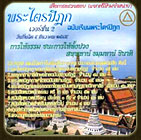
BUDSIR II was completed in September 1989 and consisted of the Romanized Tripitaka for dissemination abroad. BUDSIR III was further developed in April 1990 to support more complex search functions.
BUDSIR IV consolidated the Tripitaka, commentaries, judicial opinions, and all texts used in the Dhamma studies curriculum. It also included the Romanized version, totaling 115 volumes or approximately 450 million characters, making it the most complete computer-based Tripitaka and commentaries available today. Mahidol University later enhanced the project by recording the Tripitaka and commentaries onto CD-ROMs, completed in July 1994, greatly facilitating study and research for both Thai and international scholars. The university presented this work to His Majesty King Bhumibol Adulyadej and Her Royal Highness Princess Maha Chakri Sirindhorn on 18 January 1995.
“Subsequently, as computer technology advanced and made it possible to convert characters into various scripts used worldwide, the project developed the Pali Tripitaka in nine different scripts: Devanagari, Roman, Sinhalese, Burmese, Khmer, Lanna, Mon, Lao, and Vietnamese. The original Thai-script Pali texts were used as the source, and an interface program was created to display the content in multiple scripts for each language. The system also allowed comparison between the Thai-script Pali Tripitaka of Siam and the Roman-script Pali version.
In 1998, the project developed a system suitable for the general public without specialized knowledge of Pali who wished to study the Tripitaka. This resulted in the Thai-language computer version of the Tripitaka with a search system called BUDSIR/TT (Buddhist Scriptures Information Retrieval For Thai Translation).
Later, BUDSIR/TT was further developed to include both the Tripitaka and commentaries, using the 45-volume Royal Thai translation of the Tripitaka recorded into the computer. A search engine was created for the Thai language, enabling users to search for words, names, places, sentences, or specific passages in all 45 volumes. The system could also display side-by-side comparisons of Thai translations with the original Pali in Thai script and could fully convert the Thai-script Pali Tripitaka into Roman-script Pali.
In 2000, the project developed an upgraded system called BUDSIR/TT V.2, incorporating applied mathematics using Boolean operators, previously used in the DOS-based version, to enhance efficiency. This system allowed searches for words in the Pali Tripitaka in Thai script, the Thai translation, and Pali commentaries using conditional operators such as AND, OR, and NOT. For example, to find the term “Kundanna” on pages or in volumes containing the phrase “the eye perceives Dhamma,” the search could be conducted with the condition: Kondanna AND the eye perceives Dhamma.”
Searching for one of two words, for example “lokuttara” or “lokiya,” can be done using the condition: lokuttara OR lokiya.
To search for a word while excluding another, for instance searching for “apath” but not “bhikkhu,” use the command: apath NOT bhikkhu.
In addition, the system includes Pali-Thai dictionaries and collections of images depicting the Buddha’s life, Buddhist pilgrimage sites, the Vessantara Jataka, and the Buddha’s victory chants, with brief descriptions for each image. These images can also be linked to relevant Tripitaka content. Details about the BUDSIR Tripitaka CD-ROM can be found at http://www.mahidol.ac.th/budsir/budsir-main.html (Reference: http://www.mahidol.ac.th/budsir/budsir-main.html, 27/05/2004).
His Majesty was honored as the “Great Computer King” for his work with these computer systems. It can be said that King Bhumibol Adulyadej was at the forefront of those keeping pace with the rapid changes of the globalized world. He was a technology leader who did not fear modern advancements, was ready to evaluate and test them personally, and could advise others on the benefits and risks of technology with fairness and foresight. It is a great blessing for the Thai people that His Majesty led in these fields.
For these reasons, combined with His Majesty’s remarkable abilities, he effectively studied and used computers, composed and recorded musical scores, created computer programs for data processing, designed beautiful Thai fonts for display on screens and printers, and used computers to record various royal duties and activities.
He established computer communication networks to support various royal duties, created New Year’s cards using computers and distributed them through the media to convey his blessings to the Thai people, and supported the creation of the Tripitaka in computer format. All of these clearly demonstrate that His Majesty King Bhumibol Adulyadej rightfully deserves the royal title unanimously bestowed by the Thai people as the “Great Computer King” (Chamnan Rodhetphai, 2002: 100–107).
2. Industrial Genius, Including Projects Supporting the Industrial Sector
His Majesty King Bhumibol Adulyadej possessed exceptional foresight and insight. He recognized the importance of integrating industrial approaches with agricultural development to ensure that production for both domestic and international trade would not be interrupted. At the same time, he saw the value of applying modern scientific knowledge in ways that were compatible with Thai wisdom. This vision led to the initiation of numerous projects, such as:
2.1 Projects for Plant Genetic Conservation and Yield Improvement: Tissue Culture Project
This project aims to help farmers produce various crops more quickly and with higher quality. Mom Luang Thavisun Ladawan (1987:19) presented a special lecture at Chulalongkorn University, stating that
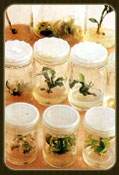
“One of the important and relatively new projects, initiated in 1985, was the Plant Tissue Culture Project, a modern scientific method. This experimental project, undertaken under the royal initiative, aimed to conserve plant species that could not be propagated by seeds, grafting, or cuttings. The method, called plant tissue culture, involves cultivating plant tissue cells in nutrient media, adjusting the formula until the plants grow healthy stems that can be transplanted without genetic mutation. Once the method was successfully tested, His Majesty graciously commanded the tissue culture of ancient plant species, including
(1) The jackfruit tree, known to have been planted since the reign of King Rama III (King Nangklao), is located at Phra Thinang Paisal Thaksin in the Grand Palace. This jackfruit produces thick flesh up to 1 centimeter, with a fully sweet taste, and even the seeds are edible. Since this tree could not be propagated by any other method, the plant tissue culture technique was used for its propagation.
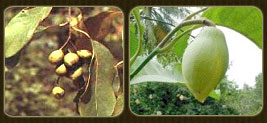
Myrobalan Wood
Scientific name: Terminalia chebula Retz.
Magnolia
Scientific name: Talauma candollei
(2) The Myrobalan tree planted by King Rama V at Phra Thinang Amphon Sathan, which bears large, non-astringent fruits. Both the jackfruit and Myrobalan trees are nearly a hundred years old. In addition, the project has conducted tissue culture experiments on various plants in the royal palace, such as Talauma and Jasmine, for the purpose of making flower garlands. A special characteristic of these flowers is that their stems are long, and even after 2–3 days, the stems remain fresh without discoloration.
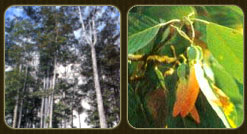
Yang
Scientific name: Dipterocarpus alatus Roxb.
(3) He made efforts to protect the Yang trees, which were at risk of extinction in their natural habitat in Tha Yang District, Phetchaburi Province. He collected seeds to cultivate at Phra Tamnak Piamsuk and personally planted them in experimental forest plots near Phra Tamnak Ruenton, Chitralada Garden. Today, the Yang forest in Chitralada Garden is a lush area resembling a natural forest and serves as an ex-situ collection of valuable plant species of the Royal Project. Additionally, it includes plant species from all over Thailand, providing students with an opportunity to study flora without needing to travel across the country.
(4) He instructed the use of plant tissue culture technology to propagate and preserve unique plant species, preventing their extinction and allowing future utilization. For example, He applied this method to propagate Pandanus and various rattan species, conducting cultivation experiments in the Yang forest of Chitralada Garden as well as at the Huai Hong Khrai and Phu Phan Development Study Centers.
These efforts demonstrate King Rama IX’s ingenuity in applying modern technologies to conserve endangered plants. His approach exemplifies royal benevolence, using demonstration methods to educate the public on the value of natural resources and showing how technology can be appropriately applied for their preservation and sustainable use.
2.2 Projects on Water Resource and Agricultural Management: “New Theory”
New Theory: Self-Sufficiency Economy
(from the book The King, the Great Engineer of the Land, published by the Engineering Institute of Thailand, 2000: pp. 72–78) stated as follows:
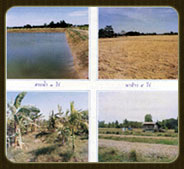
“The King gave a royal speech regarding the theory of a self-sufficiency economy as follows (2000: 72)… The New Theory is intended to prevent shortages. In normal times, it allows people to prosper; in times of hardship, it enables rapid recovery, giving people the opportunity to be self-reliant without excessive government assistance. Therefore, he supported the implementation of the New Theory…”
“The ‘New Theory’ was conceived by His Majesty King Rama IX in 1992 as a new approach to managing land and water resources for agriculture, which can be applied widely. His royal statement, ‘Water is life’, is the origin of the New Theory, as He recognized that a major obstacle for farmers is water scarcity. Even when rainfall is sufficient, there may be no water reservoirs for agricultural use. Therefore, He gave the guiding principle: ‘The solution is to collect the rainwater that falls.’”
His Majesty King Rama IX conducted a practical trial of the New Theory on land and water management for small-scale farmers owning 5–15 rai of land at Wat Mongkhon Chai Pattana, Huai Bong Subdistrict, Mueang District, Saraburi Province. He purchased the land with His own funds for the experiment, with financial support from the Chai Pattana Foundation and in cooperation with relevant government agencies, to implement integrated agriculture and the excavation of ponds for cultivation.
The King designated the approximately 15-rai area into three sections for specific purposes:
About 3 rai (30%) were excavated as a pond for water storage. If dug to a depth of 4 meters, it could hold around 10,000 cubic meters of water. The pond could be used for fish farming and aquatic plants, with vetiver grass planted along the edges for soil conservation. Surrounding the pond, soil was enriched with green manure, and flowering plants, ornamental plants, and short- and long-term vegetables were cultivated.
Five rai were used for rice cultivation, and another five rai for planting high-quality fruit trees and field crops:
2.1 Fruit crops: Long-term trees such as Santol, Jackfruit, and Mango, with short-term trees like Guava, Custard Apple, and Banana interspersed between the main trees.
2.2 Field crops: Crops grown during the dry season after rice harvest included peanuts, soybeans, fresh vegetables, and corn, using pond water as needed.The remaining 1 rai (10%) was allocated for housing, roads, earthen dikes or canals, kitchen gardens, and livestock.
The principle of the New Theory is “integration”, enabling villagers to make the most effective use of available resources, achieve self-reliance, and distribute risks. The King proposed cultivating both rice and other crops together, so villagers would have rice for household consumption throughout the year and surplus to sell for profit. Vegetables and fruits would provide additional income sufficient for a frugal household. While not necessarily wealthy, the family would be free from hunger, reflecting the principles of sufficiency economy.
His Majesty’s brilliance lay in not prescribing the cultivation of a single crop as had been traditionally practiced. He also allocated land for pond construction, recognizing that this sacrifice of land would provide the essential water resources needed to generate income and ensure sustainable livelihoods.
Beyond land allocation, He devised a step-by-step development plan for farmers:
Step 1: Teach farmers to understand and manage land for self-sufficient food production using simple, gradual methods. The aim was enough to live on—sufficient, not excessively wealthy, but free from hunger.
Step 2: Encourage farmers to form community groups, such as cooperatives, to work collectively in production and marketing. This also included improving social conditions, education, and religious practice to strengthen the community internally.
Step 3: Open the community to the external society, enabling support from various sources, negotiating with financial and energy providers, and learning to manage enterprises such as rice mills, cooperatives, and community shops. This elevated the community’s quality of life and economic strength.
Through this approach, even poor farmers could achieve self-sufficiency, foster community unity, and create strong, influential communities capable of expanding their local economy to external markets. This development reduced rural-urban migration, alleviating overcrowding and urban deterioration.
Moreover, when farmers gained income and could sustain themselves, the national economy became more stable, promoting a sustainable economic development model, as opposed to the rapid, Western-style economic growth that had previously led to national problems.
Ultimately, the New Theory can be widely applied in daily life because it serves as an inspirational concept, empowering the underprivileged to understand reality, persevere through hardships, and find happiness within their means. It teaches the principle of moderation, rooted in compassion and ethical sufficiency.
“… The New Theory … is flexible, and must be flexible, just like our lives—we all need flexibility.”
It is clear that implementing this royal initiative is not difficult, but caution is necessary. As noted in the Chai Pattana Foundation Journal (April 1994: 28):
“… Actions must be carried out carefully, with a thorough study of the terrain. For example, will a pond retain water? Solutions must be prepared for potential issues, and costs for digging ponds should be shared among the government, foundations, and private sectors, because villagers alone may struggle to bear high expenses. Most importantly, the New Theory will be fully effective only when large reservoirs and small ponds are integrated into the farm system. When applied as His Majesty intended, it results in water conservation and maximum benefit for agriculture …”
The New Theory is a universal truth that anyone can apply, achieving results according to their practice. It demonstrates that His Majesty King Bhumibol Adulyadej had extraordinary foresight and deep concern for his people. He sought ways to reduce their suffering, emphasizing the value of sufficiency, diligence, perseverance, and patience. Following His compassionate guidance is considered a great blessing for those born as Thai citizens.
2.3 Renewable Energy Project: Using Pure Palm Oil as Engine Fuel to Replace Diesel
Nowadays, the world is increasingly concerned about energy problems, as oil prices continue to rise. Almost every country has begun researching various forms of renewable energy. In Thailand, several types of renewable energy have been developed, such as ethanol, gasohol, and biodiesel. Biodiesel can be produced from various oil-producing plants, including palm, coconut, castor, and sunflower, among others.
Currently in Thailand (B.E. 2544 / 2001), biodiesel production exists in two forms: household-scale and industrial-scale.
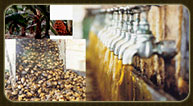
การผลิตน้ำมันปาล์มบริสุทธิ์
a. Household-scale: Produced by farmers in some communities for use in agricultural machinery, helping reduce operating costs and making full use of local raw materials. Small and large coconut and palm oil extraction plants have been established to produce biodiesel using local knowledge for sale.
For example, during the severe drop in coconut prices in B.E. 2542 (1999), a group of coconut farmers in Thap Sakae District, Prachuap Khiri Khan Province, began producing biodiesel by mixing pure coconut oil with kerosene, resulting in a production capacity of approximately 40,000 liters per day for sale.
b. Industrial-scale: This process requires scientific methods to separate biodiesel in the form of esters from vegetable oils. The process meets European and U.S. standards and is accepted by automobile manufacturers.
In the patent application filed by His Majesty King Bhumibol Adulyadej, it is specified that pure palm oil alone, or any mixture of pure palm oil and diesel in any proportion, can be used as fuel for diesel engines. This can increase engine power without modifying the engine, and no additional fuel filters or exhaust control devices are required.
Mr. Santi Rattanasuwan, Deputy Director-General of the Department of Intellectual Property, Ministry of Commerce, stated (May 4, 2001):
“…Diesel fuel has many problems, such as being imported at high cost and causing pollution harmful to humans, animals, and the environment. Diesel exhaust produces black smoke and invisible toxic gases, damages lungs, causes cancer, and increases health and environmental costs. Additionally, each rise in diesel price affects other goods. In response to these issues, His Majesty demonstrated ingenuity, finding that palm oil has the potential to replace diesel.”
The patent application was globally reported by BBC Online and in the Daily News (June 4, 2001) under the headline “Diesel Fuel from Vegetable Oil,” noting that King Bhumibol filed the patent application for using pure palm oil as fuel for diesel engines with the Department of Intellectual Property on April 10, 2001, and the application was published on April 18, 2001.
The patent explains that this invention reduces soot and harmful emissions by up to four times (approximately 33%) compared to conventional diesel. Using pure palm oil as fuel produces very low pollution because it contains no sulfur (thus avoiding acid rain), is biodegradable, non-flammable (flash point about 170°C), and has excellent lubricating properties. It does not require electronic fuel injection control, additional filters, exhaust devices, or engine modifications, and it can increase engine power without a turbocharger.
Thus, using pure palm oil as diesel fuel is an environmentally friendly alternative, supports farmers when crop prices fall, and promotes the cultivation of renewable, fast-growing palm crops. “
3. The Royal Genius in Transportation
Transportation Projects: Traffic Problem Solutions for Bangkok and Its Metropolitan Area
A severe problem for residents of major cities like Bangkok is traffic congestion, which causes enormous economic and social losses. His Majesty King Bhumibol Adulyadej the Great was well aware of this issue and deeply concerned about the people of Bangkok and its surrounding areas, whose hardships differ from those of rural communities. He conceived a principle to address the problem by constructing main roads to alleviate traffic congestion, based on the idea of designating land use areas for various activities in a coordinated manner. With a road network serving as integrated transportation routes, His Majesty judged that arranging roads in loop patterns to allow vehicles to move quickly and avoid congested city center areas would be an effective solution to traffic problems.
The projects initiated from His Majesty’s royal guidance and judgment to resolve traffic issues are as follows:
3.1 Ratchadaphisek Ring Road Project: This project began in 1971 as a gift to the people on the occasion of His Majesty’s 25th anniversary of reign. It was completed on August 12, 1993, taking 23 years to construct. It was the first project initiated from His Majesty King Bhumibol Adulyadej’s royal guidance to solve traffic problems, conceived long before traffic had become as critical as it is today.
“… This project has taken 23 years to complete. We must find ways to continue addressing the problem and not be discouraged, thinking ‘Oh, if we start now, it will take another five years to finish.’ It will be completed if we begin today. If people start taking action, they will be motivated, and once motivated, they can endure heavy traffic and cooperate in the work we are doing to solve the problem …”
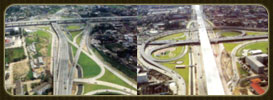
Ratchadaphisek Ring Road
The general characteristics of Ratchadaphisek Road are that it is a ring road or circular road, including elevated sections, constructed to facilitate traffic between one suburban area and another without having to pass through the congested city center. The route of Ratchadaphisek Road starts at Tha Phra Intersection, crosses Taksin Road, spans the Bangkok Bridge, passes Charoen Krung Road, Sathu Pradit Road, Nang Linchi Road near Khlong Toei Pier, continues along Rama IV Road into the land of the Tobacco Factory, follows Sukhumvit Road along Asok Road, passes Lat Phrao Road, Phahonyothin Road, Vibhavadi Rangsit Road, and Prachachuen Road, then follows Wong Sawang Road across the Chao Phraya River to join Charansanitwong Road, continuing along the road until returning to Tha Phra Intersection. The total length is approximately 45 kilometers, with about 18 kilometers using existing roads and approximately 27 kilometers on newly constructed routes.
The final project that completed the ring was the Ratchadaphisek–Vibhavadi Rangsit Interchange project, a semi-directional loop type interchange connecting Vibhavadi Rangsit Road, Ratchadaphisek Road, and Kamphaeng Phet 2 Road. This allows traffic to flow continuously without vehicles having to stop at traffic signals.
His Majesty King Rama IX graciously bestowed the name for this elevated road, including the sections planned for future connection, with a single name throughout: “Uttara Phimuk Road,” which means “facing north.”
The great benevolence of His Majesty King Rama IX is evident, as he bestowed this for all Thai citizens throughout the country.
3.2 Industrial Ring Road Network
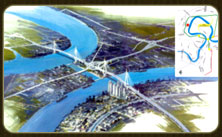
Industrial Ring Road
The Industrial Ring Road network is a traffic alleviation project initiated according to the royal initiative of His Majesty the King. It spans a total length of 25 kilometers and aims to facilitate the transport and movement of goods between Bangkok Port, industrial factories in Samut Prakan Province, and other regions of the country, without passing through central Bangkok. This helps to solve traffic congestion in the industrial areas of southern Bangkok, extending to Samut Prakan Province.
This Industrial Ring Road network is divided into two parts: road works, including Rama III Road, the old railway road, and Pu Chao Saming Phrai Road; and the bridge across the Chao Phraya River, which connects Rama III Road with Pu Chao Saming Phrai Road.
Additionally, there is another sub-project in the same area, inspired by the royal initiative of His Majesty the King: “… There should be a shortcut canal of an irrigation nature, which will also help drain water. When the Chao Phraya River flows to the sea, it takes a long detour and finally returns nearby. Therefore, if we dig a shortcut canal here, water coming from the north will flow to the sea faster …”
The Royal Irrigation Department implemented this royal initiative by constructing the Lat Pho Canal in Phra Pradaeng District, Samut Prakan Province, as a drainage canal to speed up the flow of water from the Chao Phraya River through Bang Krachao, an area where the river naturally slows, allowing the water to reach the sea more quickly and preventing seawater from flowing back into the inner areas.
The Ministry of Transport requested royal permission to name the outer Bangkok Ring Road after the Golden Jubilee ceremony, calling it “Kanchanaphisek Road,” and changed its route number from 37 to 9 to honor the King and integrate it into the national expressway system.
3.3 West–East Quadrant Network
This is a continuous and comprehensive traffic network currently under development, designed to connect the western and eastern sides of Bangkok.
The portion of this network that has already been implemented includes the west–east road alignment, consisting of several road and bridge projects connected from the Taling Chan–Nakhon Chai Si area to Borommaratchachonnani Road (or the elevated parallel road), crossing the Chao Phraya River to the eastern side of Bangkok, and continuing along Sri Ayutthaya Road, Asok-Din Daeng Road (along Makkasan Reservoir), Bang Kapi Canal Road (from Makkasan Reservoir to the A.S.M.T. intersection), up to Rama IX Road (under the expressway from A.S.M.T. intersection to Rama IX Road).
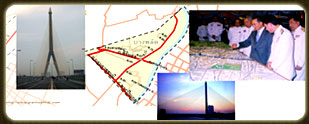
Rama VIII Bridge
The most important part of the West–East Quadrant Network is the Rama VIII Bridge, a new bridge across the Chao Phraya River that connects with the elevated parallel road of Borommaratchachonnani Road at the Arun Amarin intersection, crosses the Chao Phraya River, and meets the end of Wisutthikasat Road near the Bank of Thailand. This bridge helps relieve traffic from the Phra Pinklao Bridge and Krung Thonburi Bridge and reduces congestion on nearby roads, including Borommaratchachonnani Road, Sirindhorn Road, Ratchawithi Road, Charan Sanitwong Road, and Ratchadamnoen Road.
3.4 Borommaratchachonnani Elevated Parallel Road Project
During His Majesty the King’s visit to check on the health of Her Royal Highness Princess Srinagarindra at Siriraj Hospital in June 1995, He observed severe traffic congestion from Phra Pinklao Bridge extending to Borommaratchachonnani Road. He then provided the royal initiative to construct an elevated parallel road from the base of Phra Pinklao Bridge to the New Southern Bus Terminal area. Regarding the outbound route, “… If an elevated outbound bridge is extended beyond the Southern Bus Terminal, it would be very beneficial …”
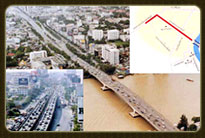
Borommaratchachonnani Elevated Parallel Road
Following this royal initiative, Mr. Banharn Silpa-archa, who was Prime Minister at the time, held a meeting with the Bangkok Metropolitan Administration to implement the King’s guidance. The conclusion was that Bangkok would be responsible for constructing the elevated parallel road from the Arun Amarin Intersection to Khlong Bangkok Noi, a distance of approximately 3.2 kilometers, while the Department of Highways would be responsible for construction from Khlong Bangkok Noi to Phutthamonthon Sai 2 Intersection, using a uniform design for the bridges, pillars, and beams over a distance of 9.4 kilometers. Additionally, from the Sirindhorn Interchange to beyond Phutthamonthon Sai 2 Intersection, another 1 kilometer would be constructed. The Department of Highways also expanded the ground-level lanes from 8 to 12 lanes.
His Majesty King Bhumibol Adulyadej approved the proposal and graciously presided over the laying of the foundation stone for the project on April 16, 1996, and officially inaugurated the Borommaratchachonnani Elevated Parallel Road on April 21, 1998. This parallel road effectively alleviates traffic congestion in the area, demonstrating the King’s benevolence and remarkable foresight (Ministry of Transport, 1999: 84–93).
4. Royal Genius in Telecommunications
The Ministry of Transport (1999: 139–159) described the royal genius of His Majesty the King as follows:
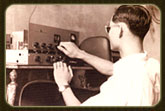
4.1 The Department of Post and Telegraph respectfully dedicated a radio frequency to the A.S. Dusit Palace Radio Station.
In September 1952, while His Majesty King Rama IX resided at Amphorn Sathan Throne Hall, the Public Relations Department respectfully installed and dedicated a 100-watt longwave and shortwave radio transmitter, broadcasting simultaneously on both longwave and shortwave in the A.M. system. This was a network radio station of the Radio Thailand broadcasting network, the only station permitted by the Department of Post and Telegraph to transmit signals. The Department of Post and Telegraph assigned the frequency for the A.M. system: the longwave used a frequency of 1332 kHz with a wavelength of 225 meters, and the initial shortwave used a frequency of 6404 kHz with a wavelength of 46.8 meters.
His Majesty King Rama IX named this radio station “A.S. Dusit Palace Radio Station,” where “A.S.” stands for “Amphorn Sathan,” the location of the first broadcast. Later, in 1957, the station was moved to the Chitralada Royal Villa premises.
Originally, shortwave broadcasting used the 6404 kHz frequency. In 1974, according to Article 32, Section 1173 of the International Telecommunication Union’s radio regulations, coast stations were required to use that frequency for maritime mobile service communications with ships. Therefore, the Department of Post and Telegraph instructed the A.S. Radio Station to change its shortwave frequency to 6150 kHz in September 1974.
Later, on 24 June 1983, the National Broadcasting and Television Commission established a working committee to develop a national A.M. radio frequency allocation plan. The committee prepared the allocation plan to resolve signal interference issues. According to this plan, the A.S. Radio Station was required to change its frequency from 1332 kHz to 1341 kHz. In 1995, the national A.M. radio frequency allocation plan was reviewed and revised, allowing the A.S. Dusit Palace Radio Station to return to its original frequency of 1332 kHz.
For the F.M. broadcasting system, the Public Relations Department requested permission from the National Broadcasting and Television Commission (NBTC) to establish a 10-kilowatt F.M. radio station at a frequency of 104 MHz, to be dedicated to the A.S. Radio Station. The technical subcommittee, chaired by the Director-General of the Department of Post and Telegraph, reviewed and approved the allocation of the 104 MHz frequency with 10 kW power to A.S. Dusit Palace Radio Station on 2 July 1982.
4.2 Dedication of the call sign VR009
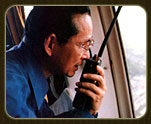
His Majesty King Rama IX showed great interest in communications via amateur radio networks. He personally experimented with radio wave propagation and signal reception. He strictly adhered to the regulations of radio communication, both regarding the accuracy of spoken communication and the use of radio equipment that met international standards. He would correct and admonish any amateur radio operator who did not follow the rules, while at the same time graciously offering advice and explaining technical issues in simple language to resolve any confusion.
For this reason, when the Department of Posts and Telegraphs established the Voluntary Radio Club, abbreviated in English as VR, the department respectfully presented the call sign VR009 to His Majesty the King on December 5, 1981, in deep gratitude for His boundless royal benevolence.
4.3 National Radio Frequency Coordination and Administration Committee (NRFC)
His Majesty was presented with the high-level amateur radio operator certificate and the call sign HS1A at Chitralada Royal Palace on Thursday, August 17, 1989.
King Rama IX responded with the following royal address on the occasion when the Deputy Minister of Transport and the committee paid respects and presented the certificate and call sign.
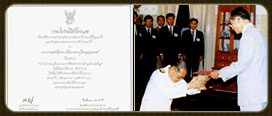
“I would like to thank you for coming to offer your blessings and to present the certificate for the Advanced Amateur Radio Operator along with the call sign. It brings me great joy, because it signifies that those engaged in amateur and voluntary radio have practiced for a considerable period, gaining a solid understanding of radio operations and effective methods of study…
… For those who come to learn and practice as volunteers, it is even more important to understand the significance, because those who do it professionally must study extensively and possess great skill and responsibility. If a professional makes a mistake, there are consequences. For volunteers or amateurs, it is not that there are no consequences, but the key point is that one must take full personal responsibility to maintain standards, because whatever is transmitted can have repercussions nationwide, affecting everyone. Therefore, it is essential to observe communication discipline carefully to ensure effective communication, avoid interference with others, and not compromise public safety…
… I would like to thank all of you who have come today, and I wish everyone success in their endeavors for the prosperity of the community, and may you all enjoy robust health, strong spirit, and success in every aspect.”
4.3.1 Royal Guidance for the Officers at the Sailom Center, Department of Posts and Telegraphs
His Majesty King Rama IX first used amateur radio networks in 1985 and communicated via radio with the Sailom Center, Department of Posts and Telegraphs, to test signals on multiple occasions. On some of these occasions, He graciously provided technical advice regarding the tuning of complex transceivers, as well as knowledge on antennas, radio wave propagation, types of interference in various networks, and methods to resolve such interference, for example:
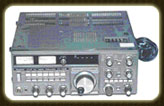
King Bhumibol Adulyadej (Rama IX) provided guidance on the use of transceivers at the Sailom Center when the center received a fixed-installation YAESU FT-726R transceiver from VR241 around July 1985. At that time, VR241 also presented an identical set of this radio to His Majesty. When the Sailom Center began using the transceiver, the radio operators were unable to operate its numerous controls correctly, which led to reporting errors. Several amateur radio members inquired about the apparent malfunction of the center’s equipment.
His Majesty then sent instructions over the amateur radio network on the calling frequency, stating: “The Sailom radio is a sibling of VR009,” and provided step-by-step guidance on operating the transceiver, enabling the Sailom Center staff to correctly adjust all controls.
During the first signal test in 1985 with the Sailom Center, the King called, “VR009, checking the net,” and the center staff reported, “Your signal VR009 59+60 dB 73.” This marked a memorable day for the Sailom Center of the Department of Posts and Telecommunications. After this historic event, His Majesty tested signals with the center many times and nearly every time provided technical advice on communication.
For example, on July 2, 1985, during a signal test, he inquired whether the Sailom Center experienced much interference. The staff reported that sometimes the center received QR Nancy at 55 dB, making it difficult to receive member signals. The King advised resolving the interference by installing a cavity.
He also asked about jamming from broadcast radio signals, as he heard music and understood it entered through the Sailom audio line. The center staff reported they had tried to find the cause and suspected the radio’s grounding might be poor, though they could not identify the source of modulation. His Majesty explained that the modulation entered via the microphone line and suggested that improving the grounding could reduce the interference.
Otherwise, a low-pass filter might be required. However, if one removes the microphone cable, cleans it, and reconnects it, the problem may improve. Otherwise, a protective circuit would need to be installed. This method can mitigate interference from broadcast radio signals. With his ingenuity, His Majesty coined the term for interference caused by intermodulation as “Radio Pollution.”
On July 11, 1985, he provided guidance on lightning protection.
On July 12, 1985, at 2:30 a.m., VR969 and VR938 went to assist members whose vehicles were stranded in floodwaters. His Majesty contacted them to provide encouragement and guidance for returning home safely.
On July 17, 1985, while giving instructions on using the fixed-installation YAESU FT-726R transceiver, a key was pressed for nearly 25 seconds. He inquired whether it was the Sailom Center pressing the key, and upon learning it was not, he reported the signal: “The key pressed belongs to someone else; the signal is slightly off.” He then remarked, “Perhaps because we have monopolized this frequency for so long, others wish to enter. If they do, go ahead. VR009 will clear it—no need to break.”
4.3.2 His Majesty graciously provided assistance to the officials of the Department of Posts and Telecommunications during the 13th SEA Games (December 8–17, 1985). The department was assigned by the organizing committee to manage the communication system for coordinating various committee branches. The SEA Games required multiple venues, including locations in Bangkok and other provinces, such as Chonburi for sailing and the Chonburi–Rayong route for long-distance cycling competitions.
Therefore, in preparing the radio communication network for the organizing committee to use efficiently over long distances, it was necessary to employ a signal repeater. When deciding to use the repeater, an initial survey of repeater station locations was conducted, along with the procurement of repeater equipment and installation sites. Cooperation was requested from the Electricity Generating Authority to use the site at Khao Chalak, Si Racha District, Chonburi Province, and installation was completed shortly before the scheduled competition.
The trial revealed problems: the repeater could not function as expected, experiencing interference that caused it to work intermittently. Mr. Manat Songsang, an official of the Department of Posts and Telecommunications responsible for procuring communication equipment and installing the system, had to urgently resolve the interference issue to ensure the repeater operated correctly. Failure to do so could have jeopardized the SEA Games, which Thailand had the honor of hosting. Despite prolonged efforts, the problem persisted.
Finally, during signal testing, His Majesty King Rama IX contacted the frequency being tested and inquired about details such as the transmit and receive frequencies of the repeater, the type of antenna system used, the nature of signal propagation, the installation method, and whether any filter circuits were in use.
He graciously provided step-by-step guidance, including recommendations on VHF and UHF repeater frequencies, optimal frequency selection, and proper antenna installation for effective operation. With His Majesty’s profound insight, the repeater system was successfully made operational, demonstrating his exceptional ingenuity and boundless benevolence toward the officials of the Department of Posts and Telecommunications.
On August 4, 1983, His Majesty King Rama IX graciously issued a royal command on the occasion of the 100th anniversary of the Department of Posts and Telecommunications, typing it himself on a telex machine.
Pol. Maj. Gen. Suchart Phueaksakon wrote an article about His Majesty’s ingenuity in telex operations (http://www.dabos.or.th/ro2.html, 28/11/44), stating:
“… The first telex machine presented to His Majesty was manufactured by SIEMENS AG, Federal Republic of Germany. It featured a keyboard with both Thai and English characters and could communicate directly with key agencies nationwide, both central and regional.
… During disasters causing hardship to the people, or in normal times when important news required His Majesty’s attention, these agencies could report directly via telex. This ensured that the King would be promptly informed of the welfare of his subjects, enabling him to issue orders or provide aid immediately… For example, the Royal Rainmaking Project succeeded each time thanks to coordination with relevant agencies, such as the Meteorological Department.
When sending news via telex, His Majesty preferred to manually perforate the message onto the telex tape himself… He meticulously edited the tape to perfection, even for long messages requiring considerable time to assemble.
Every New Year’s Eve and New Year’s Day, in addition to giving royal blessings to the people via television and radio, His Majesty also graciously extended greetings to agencies he was familiar with and collaborated with via radio and telex, as illustrated below.
GS 9 expresses gratitude to everyone and takes the opportunity to offer New Year blessings in the following words:
Agree with each other, speak beautifully, have a steadfast mind.
Be diligent, work honestly, think well.
Be bright, beautiful, calm, and peaceful.
This is the path to dispel sorrow and grief, achieving happiness and prosperity.
GS 9 typed on December 31, 1986.”
4.4 His Majesty graciously imparted knowledge on satellite communications
His Majesty King Rama IX’s ingenuity in satellite communications began when Thailand first utilized Intelsat satellites for international communications in 1967. The Department of Posts and Telecommunications had the honor of serving His Majesty and Her Majesty the Queen Mother. While His Majesty was in communication via telephone with His Royal Highness the Crown Prince of Thailand, who was studying in Australia, using satellite communication signals, His Majesty provided guidance and encouragement to the staff working in this field, as at that time the technology was still complex for a developing country like Thailand.
Spirit of Chiang Mai records a historic event in global satellite communications when Thailand hosted the 13th Intelsat Administrative Council meeting from January 8–16, 1975. Around 48 Intelsat board members, 34 organization staff, and 12 Thai officials from the Department of Posts and Telecommunications were granted royal permission to pay homage to His Majesty at Phuping Palace on the afternoon of Saturday, January 11, 1975.
His Majesty warmly interacted with all attendees and graciously hosted afternoon tea. On this occasion, He provided detailed guidance on satellite communications, which had only been in operation for about 10 years, including insights on radio communications, such as:
His Majesty’s explanations on the propagation and interference of radio waves, experiences in transmitting and receiving signals of different sizes, and developments in communications technology greatly impressed the Intelsat Administrative Council—a group of the world’s leading communication experts—who had never before anticipated such profound technical knowledge and practical skill from King Rama IX.
Even in subsequent council meetings, held every three months (mostly in Washington, D.C., and once a year in rotating member countries), participants often recalled the 1975 meeting in Thailand and the audience with His Majesty at Phuping Palace. Whenever problems arose, they would think back to the Spirit of Chiang Mai, which served as a model for resolving challenges and disputes smoothly.
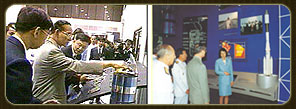
His Majesty presided over the inauguration ceremony of the Thaicom satellite station in Nonthaburi Province on 26 January 1994.
He graciously bestowed the name of the national communications satellite, “Thaicom,” as Thailand’s first domestic communications satellite, in accordance with the government’s policy to establish a national satellite for the country.
The word “ไทยคม (THAICOM)” is written in English as “THAICOM,” derived from “THAICOM(MUNICATION).” His Majesty King Bhumibol Adulyadej graciously presided over the inauguration ceremony of the Thaicom satellite station in Nonthaburi Province on 26 January 1994.
4.5 His Majesty’s Guidance on Telephone System Improvements
Regarding telephone communications, the Telephone Organization of Thailand (TOT) began officially serving His Majesty around 1962 by establishing telephone lines and telecommunications circuits at various royal residences. For Chitralada Royal Palace, in 1991 TOT undertook a project to expand and cut over telephone numbers from Chitralada and part of Krungkasem exchanges to create the most modern telephone exchange in terms of equipment and technology. A new telephone exchange building was constructed within the palace.
As with other communication systems, His Majesty frequently provided guidance to staff. For example, during early visits to Phu Phing Ratchaniwet Palace, TOT used a single VHF radio circuit because laying telephone lines to the palace was not yet feasible. At that time, the radio could communicate with only one network at a time.
His Majesty remarked, “It would be good to find a way for a single radio to connect to multiple communication networks.” Subsequently, TOT integrated all available networks in the country, allowing His Majesty to receive information from just one communication device.
4.6 Meteorological Forecasting
One of the greatest royal benevolences of His Majesty King Bhumibol Adulyadej was his long-standing interest in meteorological communications. He recognized that meteorology significantly affects the lives of Thai citizens, particularly farmers, and devoted sustained attention to its development.
Understanding weather conditions provides significant benefits for agriculture, enabling farmers to increase crop yields. In this regard, His Majesty King Bhumibol Adulyadej graciously directed successive Directors-General of the Meteorological Department to serve in preparing weather maps and forecasts, in collaboration with the Royal Rainmaking and Agricultural Aviation Department, a practice that continues to this day.
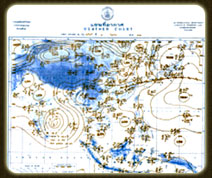
Meteorological map
In weather forecasting, His Majesty King Bhumibol Adulyadej utilized meteorological data from satellite images, such as Japan’s GMS satellites, India’s INSAT satellites, and the United States’ NOAA satellites, which the Meteorological Department presented to Him daily. He also selected data from other countries through various communication systems, employing modern technology—for example, using computers to retrieve information from the Internet—to assess weather conditions affecting Thailand, as stated in His Royal Speech to various visitors paying homage on the occasion of His birthday at Dusidalai Hall on Monday, 4 December 1995.
“… Thailand is truly remarkable, yet various events occur, such as floods that cause significant distress—not only in Bangkok and its vicinity but stretching from the North down to the South, including the Northeast. When the floodwaters were nearly receding, the Meteorological Department, through Mr. Smit Thammasaros, sent a weather forecast along with a note stating, ‘Presented for His consideration regarding the weather forecast and storm movement forecast.’ Upon reviewing the map, it was concerning because the storm Angela appeared large and swollen, like the ‘Angela’ character in the cartoon ‘Popeye.’
Mr. Smit explained that Angela was a super typhoon, deadly in the Philippines, reportedly killing over a thousand people, and had passed through the South China Sea. Receiving the forecast in the afternoon, by late afternoon we had to consider what to do. Reviewing until about 1 a.m., it seemed necessary to apply some “IT”—Information Technology. It appeared that Angela’s strength would weaken; it needed to be communicated that it would be subdued by “Nang Mani Mekhala.” Thus, at 1 a.m., instructions were given to the Meteorological Department that by ‘tomorrow’—whether Thai or Western time—the storm would become a depression and, within the next two days, a low-pressure area near Hainan or approaching China, addressing the forecast concerns.
The following day, the IT check continued. Fortunately, the assessment was reasonably accurate. Meanwhile, CNN and BBC still reported it as a typhoon; the next day it remained a typhoon, then downgraded to a Severe Tropical Storm, yet not intense. Our assurance was that Thailand would remain safe. ‘Ms. Angela’ did not enter, though Mr. Smit initially thought it would. Apologies to Mr. Smit, who inquired about the outcome, and the matter was entrusted to ‘Nang Mani Mekhala.’
Negotiations were successful. Had it followed the previous pattern—typhoons crossing Vietnam into Thailand, passing Mukdahan or Ubon Ratchathani—it would have caused significant damage. This time, however, nothing occurred…”
Dr. Sumet Tantivejakul recounted this at the Assembly of the Land of Dharma, Land of Gold, in April 1996.
“… One may not realize that in this era of information technology, His Majesty was one of the few on this land with the most complete information system.
He would track storms from as far as Hawaii, calculating their speed, distance per minute, and intensity… Upon reaching Thai territory, he would determine rainfall amounts, the paths of water flow through rivers such as the Chao Phraya and Pasak, and estimate the time it would take to reach Bangkok. This is a very complex task—even the responsible agencies could not perform such detailed calculations; they only knew that floods were coming and would casually continue their daily routines.
His Majesty could not stand idly by. Around 9 or 10 p.m., he would take action, calling and issuing instructions. As King, there is no formal requirement for him to intervene in such work, which is normally the responsibility of the government or relevant agencies…”
The royal brilliance of King Rama IX in meteorology and his compassionate leadership helped protect the nation and its people from numerous disasters. His Majesty dedicated himself with tireless effort to study, analyze, research, and forecast weather patterns with remarkable accuracy. He could predict the type and location of weather conditions or impending natural hazards even before the Meteorological Department issued forecasts.
It is therefore unsurprising that His Majesty’s relief units, particularly the Chaiprakarn Foundation, often reached affected areas before any other government agency. When volatile weather threatened the country, he would provide guidance to relevant authorities to accelerate preventive measures and mitigation efforts. In areas prone to flooding or flash floods, he graciously instructed the Royal Irrigation Department to construct canals, ditches, swamps, or irrigation channels to distribute water to lowlands or remote regions.
Through his boundless compassion and concern for the people, he devoted his intellect, effort, and energy to mastering modern sciences—satellite communication, computing, and meteorological data—to apply them for the public benefit. The results of his work have been evident both nationally and internationally.”
Therefore, on the auspicious occasion of the Golden Jubilee of His Majesty’s reign in 1996, the World Meteorological Organization, through Professor Dr. Godwin O.P. Obasi, Secretary-General of the Organization, requested permission to present a plaque and a certificate of recognition to His Majesty on 18 February 1997. This was in honor of His Majesty’s exceptional wisdom and royal ingenuity in applying meteorological knowledge and judgment to solve problems, thereby mitigating the impact of natural disasters on the Thai people (Ministry of Transport, 1999: 154–159).
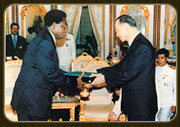
It is evident that His Majesty King Bhumibol Adulyadej (Rama IX) bestowed boundless benevolence upon all his subjects. Throughout his 57-year reign, He attentively observed the joys and sorrows of the people, alleviating their hardships and suffering with remarkable effectiveness and swiftness. This was made possible because He “reached the heart of the problem” and addressed it with royal judgment grounded in reality and the appropriateness of the situation, as celebrated in the following eulogy of His Majesty’s illustrious deeds:
“… He was mindful of the hardships of the people and analyzed the root causes of the problems clearly.
… He studied ways to solve problems concretely, based on sound academic principles.
… He assigned relevant individuals and agencies to implement solutions, monitored the results, and applied ‘management’ to coordinate different groups for effective outcomes.”
In summary, he focused on developing the ‘mind/spirit’ alongside the ‘material/physical’ aspects.

